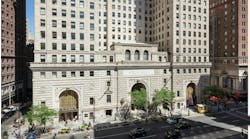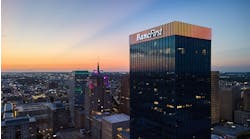Known to some as the "West Coast Pentagon," the unique pyramid architecture of the Chet Holifield Federal Building is a well-known landmark in southern California. Today this federal building boasts a new roofing system that was part of an overall exterior remodeling project that included roofing, decking, and patio structures.It is the General Services Administration's (GSA) third-largest building and consists of a main office building which houses the Internal Revenue Service, the National Archives, and other Federal tenants. It also includes a plant services building that contains offices, workshops, garage bays, and a central plant that houses the equipment for the cooling system used for the main building. As part of a long-term remodel, the roofing segment of the Chet Holifield building was overwhelming. "When the federal government has a standard roofing job, they use their own crews, but when they have a job like the Chet Holifield Federal Building, they call us," said Douglas Keith, assistant project manager for Western Roofing. "For this job, we knew we needed a roofing product that would work while having very low impact on the tenants. We recommended Polyglass ADESO™ Dual Compound Self Adhered Roofing Membranes. It fit the bill for what we had to do."Starting in March of 2003 and ending in August 20, 2003, Western Roofing roofed one of the largest federal buildings on the West coast with 2,800 squares alone with Polyglass ADESO membranes. Not only was it a major re-roofing project, but it also had strong restrictions about smell, noise, and debris.Tenants of the building worked every day throughout the remodel. "It was mandated from the beginning that there should be absolutely no disturbance to the tenants," stated Keith. "They were especially concerned about smell. All of the intake vents needed to be covered in the areas that we were working. As we had predicted, the use of Polyglass’ ADESO™ membranes made this a moot point. There was no smell and very little noise. It was an ideal product for the job."Innovation and tradition have always been an integral part of Polyglass. After several years of research on dual-compound self-adhesive technology for roofing membranes, Polyglass has the industry with the introduction of Dual Compound Self Adhered Roofing Membranes with ADESO™ Technology.With many products trying to imitate the leading self adhesive properties of ADESO™ Technology, Polyglass has delineated their leading edge commercial roofing technology from more traditional roofing products with revolutionary characteristics such as FastLap® and SealLap technology, and most importantly, the Dual Compound technology that only Polyglass has been able to offer. It has created a product line like no other in the industry.POLYGLASS SA self adhesive membranes with ADESO™ Technology were developed based on Polyglass’ long and worldwide experience in the commercial and industrial roofing markets. The membranes comprise the latest in asphalt adhesive technology, as well as proven weatherproofing compounds, featuring smooth and mineral granule surfacing, available in various colors as needed."Western Roofing is always on the cutting edge," confirmed Keith. "We were one of the first roofing contractors on the west coast to use ADESO™ on a regular basis. With projects like the Travis Airbase and BART stations on our list of ADESO™ projects, we knew that ADESO™ would be the best system for the Holifield Federal Building."POLYGLASS SA self adhesive membranes with ADESO™ Technology includes Elastoflex SA, Polyflex SA, XTRAFLEX SA, Polyall SA, Polyram SA, PolyKool SA, and Polystick underlayment roofing products. POLYGLASS SA self adhesive membranes with ADESO™ Technology are manufactured utilizing glass fiber or polyester reinforcement, with a "true" APP, SBS, or TPO compound on the top weathering side and an aggressive self-adhesive formulation on the bottom side of the reinforcement. The self-adhering properties of the built-up membranes provide the perfect alternative when traditional adhesives or propane torch techniques are not desirable or prohibited."The self adhesive membranes do not use any kettles or torches, so there is no impact on the tenants," Keith noted. "No noise and no smell. The lack of hot kettles and torches was a real selling point. Employees were not disturbed and the safety of the project was enhanced. We pride ourselves on our safety record. Being able to roof without kettles and torches is a large step forward to a safer work area."Western also built scaffolding for the entire front of the building. "We wanted access to every level without the need to enter the building," stated Jose Peregrino, Western Roofing Services’ project superintendent. "Our crew had to meet strict security scrutiny to work on the project. Between that and not disturbing the employees, we felt the scaffolding would work best and it did."Starting in March 2003, Western Roofing tore off and installed an average of 50 squares a day using a 14-man crew. "We tore off the roof down to the lightweight concrete, or in certain areas, down to Robinson decking," Peregrino said. "The outer wings had Robinson decking with the core using lightweight concrete. ADESO membranes were used on the second through sixth floors. Due to other considerations of low impact work areas, the first and seventh floors utilized foam and coatings." "The system included Polytherm® foam insulation, an ISO system with taper system applied with Ashland adhesives, two layers of ADESO™ Elastoflex SA V base, and one layer of ADESO™ Polyflex SA P cap," Keith continued. "The second floor had 1,260 squares of ADESO roofing; third floor - 781 squares; fourth floor – 115 squares; fifth floor - 96 squares; and the sixth floor - 126 squares," Keith noted. "It was a huge job, but the job looks tremendous. The seams are straight and the roof is really beautiful.""Jose’s crew was great and their lines were straight," smiled Keith. "Floors three through five are all windows, so it is very important that the roof looks good. We wanted it perfect. We knew that the employees would be looking at it every day." In addition to the roofing, Western was also the general contractor for the remodel. As part of the roofing, they added additional ventilation and matched all site screens to match the copings. With windows looking out at every part of the roof, the look and cleanliness of the roof was important. An important element to the cleanliness of the roof was the lay of the roof and the strength of the seams and laps.POLYGLASS SA self-adhesive membranes with ADESO™ Technology are tough when laid and shrink-free. One of the defining differences is Polyglass’ U.S. patent pending unique lapping system called SealLap™, and U.S. patented granule-free system called FastLap®. These technologies allow membranes to fit tightly and bond instantaneously to each other. FastLap® is revolutionizing self-adhesives with enhanced sealing of granule-free end laps between two rolls of granular waterproofing membranes. It is a patented technology that offers a durable, tight seal at the seams and faster end laps, which lowers labor costs and eliminates callbacks and repairs. FastLap® has a granule free end lap , which is protected by a reliable release film. The film combines convenience and dependability; it is guaranteed to protect the most critical part of the roof, the seam, but can be easily removed before welding, mopping, or cold-adhering seams. It saves contractors two critical aspects in roofing – time and money. In addition to FastLap®, its sister technology, SealLap™, is a unique ‘patent-pending’ factory-applied adhesive treatment on the overlap sections, which include the side lap and end laps on the weathering (upper) surface of modified bitumen roofing membrane. This patent-pending procedure offers highly enhanced seal between the membranes. This feature allows the installation of self-adhesive membranes, without compromising the integrity of the roof, and without the time, danger and expense of field-applied heat. The seal is immediate and becomes irreversible when activated by heat and pressure. The SealLap™ feature guarantees instantaneous bond between adjacent rolls, even at low temperatures. Polyglass continues to manufacture innovative roofing products with ADESO™ Technology. This technology offers the industry a safer and more efficient place to work. This was not lost to the overseeing eyes of two well-known roofing consulting firms, CRC Consulting Group Inc. and Independent Roof Consultants (IRC). "We had two inspectors on the job full time," Keith said. "Reports were good every day without any problems. We never lost anytime due to inspections. It was a combination of the product and the expertise of our crews. It kept us on time and on task.""Our crews had to be fast and clean," stated Peregrino. "We have worked with ADESO™ before and we really like it. It is easy to install and easy to roll out. We also do not get the call backs which is very important." "The size of the building was equivalent to 1 ½ shopping malls. Since it was a federal job, it was on Bacon Davis wage," Keith continued. "Efficiency was critical, as it is with all jobs, but especially on government jobs. Western Roofing had to do things efficiently to keep the job in budget and on time."Another important time saver for the job was constant support from the Polyglass Technical Department. "Steve Wadding and Rand McReynolds worked very closely with us on warranty and technical issues," confirmed Keith. "It really helped keep the job moving and guaranteed the highest quality."Due to the inclusion of very strong insulation for the roofing, the re-roof also contributed to an estimated energy savings for the building that is calculated to save the federal government $650,000 per year. "Energy efficiency is a leading issue in California and the savings and rebates continue to push the market. Polyglass’ ADESO™ membranes fit perfect into the movement towards energy savings and sustainability," says Keith."Self-adhesive membranes are leading the market as the new ecological roofing product due to the lack of VOCs and solid wastes, along with the lack of petroleum products in the installation process," stated Natalino Zanchetta, executive vice president of U.S. Operations. "With this project being congressionally funded, it was a bonus to have a self adhesive roofing system with insulation that could enhance the overall savings incentives of the building’s remodel.""We are very proud of Western Roofing and our dual compound self-adhesive membranes with ADESO™ Technology," concluded Zanchetta. "We know it is the wave of the future and we are happy to be a part of it."
Voice your opinion!
Voice your opinion!
To join the conversation, and become an exclusive member of Buildings, create an account today!
Sponsored Recommendations
Sponsored Recommendations
Latest from Case Studies
Latest from Case Studies
Sponsored
Sponsored

